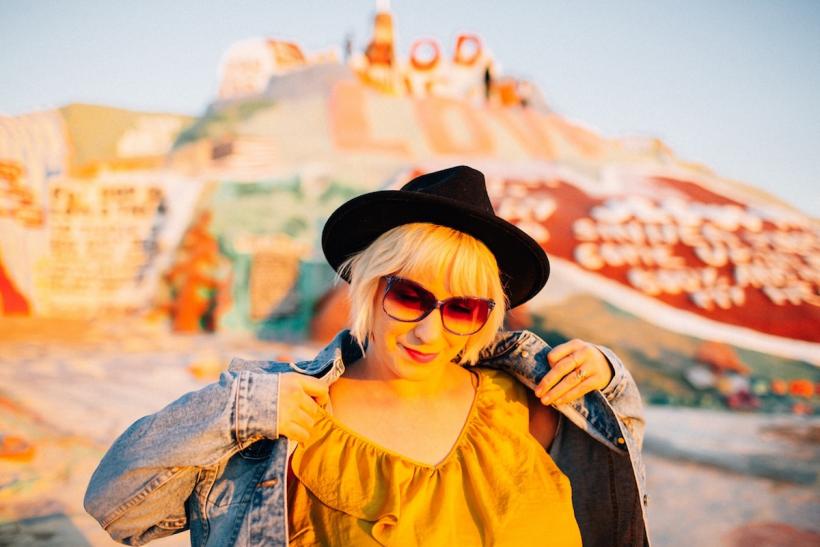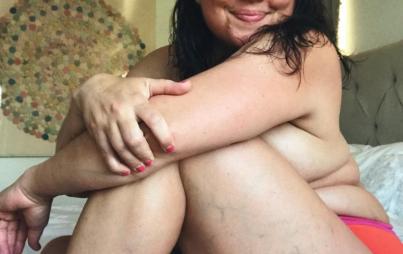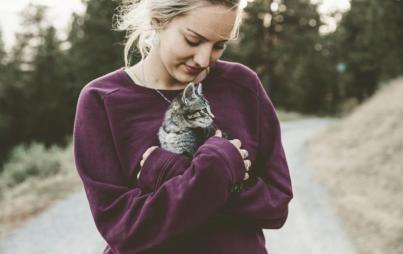
Style Ethic's Kat Eves wears vintage Asos from Alex Michael May's closet at The Plus Bus. Photo by Rob Eves Photos.
Fashion is many things. From self-expression to status (or anti-status) symbols, it can be used as a tool to convey a million different things about yourself. Beyond being a tool, fashion is a $1.2 trillion dollar global industry with more than $250 billion spent each year within the United States. In the U.S. alone, 1.9 million people are employed within the fashion and apparel industry from manufacturing to boutiques and beyond.
With that kind of production, we have to examine the environmental impact of one of the world’s biggest industries, as well as how the workers producing the garments are treated.
Ravishly spoke with size-inclusive sustainable clothing designer Yabette Swank of Swankety Swank: Global Citizen Designs, ethical designer Mary Alice Duff of Alice Alexander, and Style Ethic’s Kat Eves, a Hollywood stylist specializing in plus-size bodies, whose business model is based around ethical and sustainable fashions.
Racked writer Amanda Mull cites a Bloomberg article in which we learn that the “plus-size retail apparel market represents a $20 billion opportunity, with growth outpacing the overall market 17 percent to 7 percent in 2016 and a consumer base starved for quality clothing.”
If the plus-size market is literally one of the fastest-growing markets within apparel, then why are fat bodies almost exclusively left with fast fashion choices?
“Women over a certain size are always [treated as] a burden, never a priority. They’re expected to wait while others are served first,” Mull sums up the treatment of an ethical brand as it rolls out options for children’s wear but has not gone above an XL.
Sustainable and ethical practices are vital to our environment, but far too often plus-size customers are left out of the conversation. As consumers, fat money spends, but statistically-speaking, less of it is spent. Of the estimated $250 billion spent each year in the U.S., $21 Billion is spent by plus-size customers, the majority of which are women, and even less of that on sustainable and ethically-produced clothing.
If 67% of American women are a size 14 or larger, then why don’t those numbers line up in sales?
“The margins for most fashion designers are pretty slim, so a brand has to know with real certainty that if they expand their sizing, plus size customers will buy. The truth is, while our spending power is unparalleled, we are spending most of it on fast fashion. It’s hard for indie and artisan brands to compete for our dollars,” says Eves.
With eight out of ten businesses failing within the first 18 months, it can be incredibly scary for indie business owners to make the leap of faith and extend into a market where the numbers do not always line up with what should be the demand. While most people would think of themselves of people who care about the world around them, our shopping habits do not always reflect our ideas of who we like to think we are — but credit card receipts and bank statements tell the truth, as do the tags on our clothing.
“This is is a vulnerable and hard-to-talk-about subject for me. So far, the majority of sales for my brand are NOT from plus size consumers.” says. Swank, a plus-size woman herself.
You Might Also Like: 10 Eco (And Plus-Size!) Friendly Designers To Make Earth Day Everyday
The designer is hopeful but frustrated. After ramping up efforts to produce off-rack options up to 3x (with free custom sizing) and making an effort to offer at least one sustainable wardrobe staple under the $40 mark, the largest that she has sold since the holidays has been a size XL. She cites that the majority of her sales are a size medium.
“This can put a girl out of business, or at least really stretched resources pretty quickly,” Swank says. “It certainly discourages me from wanting to invest in even larger sizes that end up costing more.”
But why are the sales within plus-size sustainable clothing not there?
Are plus-size consumers taught that their bodies are in flux and therefore not to invest in expensive pieces because we should always be trying to reduce our bodies? The effects of the diet industrial complex have rippling consequences.
“We have a society that shoves the diet industry on us full force and it may be unbeknownst to us — even the most aware fatties — we still may abide to that in some way,” plus-size blogger and vintage lover Nicole Rieder says in an interview with HelloGiggles in which she explains why musician-turned-designer Beth Ditto’s ethically-produced line was financially out of reach for herself and many plus-size consumers. By the end of 2017, Ditto had deeply discounted her line by more than 80% and announced that she’d put the line on hold to focus on other endeavors.
“The feedback I've gotten is [that] a lot of women feel like it's a poor investment since they plan on losing weight anyway. Why buy something that they're just going to sweat in and won't be able to fit in a few months?” Yolanda Williams, owner of fitness line Just Curves, told Ravishly in 2016. “I'm not going to lie, I used to think the same way. But then I realized that I need to dress the body I'm in currently, not the one I'm trying to attain.”
But not everyone agrees.
Ethical and size-inclusive designer, Mary Alice Duff, cites her own personal experiences as a plus-size consumer.
“I've read and heard lots of conflicting theories as to why plus-size bodies are often not served by sustainable and ethical brands. Excuses range from a belief that plus-size women won't spend more money on clothes (as sustainable and ethical is generally more expensive). I've heard designers lament that plus size women won't invest in quality pieces because they are always trying to lose weight (which is total bullshit, I've been the same size 16/18 for three years and I'm happy with my body as many plus size women are). I've heard designers say that they can't "afford" to extend their size range. Which again is BS,” Duff says.
“Sure, you'd have to take your existing range of patterns and recreate them in larger sizes and test them on new models, but considering the buying power of the plus size market is estimated to be about 20 billion — yes, that's billion with a B — I can't see how one wouldn't recoup their investment here. It comes down to priority. It's not impossible to design and create clothing in larger sizes, it's just not a priority for a lot of brands and therefore they don't invest the time, energy and resources.”
“I actually don't think any of the aforementioned excuses are the actual truth. I think in reality there are deeply held stereotypes about plus size bodies: that plus size women are less healthy, less concerned about the environment, more indulgent, etc. etc. which doesn't align with the "lifestyle" of said ethical and sustainable brand,” Duff concludes.
Whatever the case may be, as the middle-class shrinks and our bodies expand, plus-size consumers often have less money to make these purchases up front due to workplace discrimination. But even then, we are still making near exponential amounts more than garment workers overseas, and most of the American consumers have safe or at least comparatively safe working environments.
One of the most glaring examples of human rights violations in the garment industry was the Rana Plaza garment collapse in Bangladesh back in 2013 which killed a whopping 1,134 people. Approximately 2,500 workers were injured but able to dig themselves out from the rubble of the eight-story building to escape with their lives. The garment industry employs more than 4 million people in Bangladesh and accounts for about 80% of the country’s foreign trade. While fire and building codes may have improved since the incident, conditions for these overworked and underpaid employees, putting in sometimes 18 hours a day to meet consumer demand, are poor.
“[Rana Plaza] should have been a wake-up call for all of us. That was five years ago, and it was preventable,” Eves says of the heartbreaking incident “Some of the brands whose clothing was manufactured there acknowledged the tragedy, but by contracting rather owning factories, they could still basically wash their hands of the 1,100 people who died. That’s not OK. 'Made in the USA' does not mean it was made ethically, either. Undocumented workers are the most vulnerable to exploitation here in Los Angeles, enduring long hours and no overtime pay, sweltering hot LA summers, and even wage theft."
But what can plus-size consumers do when our voices are barely reflected within the market?
“The truth is, we haven’t demanded ethical and sustainable practices enough, if at all. In fact, we in the plus size community pretty regularly ask for the opposite of ethical and sustainable fashion — we want it fast and cheap, and with free shipping!,” Eves explains.
“I sat in the audience at Curvy Con a few years ago when an exec from JCPenney told the crowd that plus size customers are the loudest, most vocal and influential customer base they have, and that they were listening and responding by making many of our long-requested changes. Later in the day, I heard an audience member ask panelist Nicolette Mason where to find cheaper options for plus clothing. Nicolette’s answer wasn’t any different from what I would say — ‘we don’t need more cheaper options, we need more well-made options.’ We deserve that.”
The garment industry has changed exponentially over the last fifty years. Textile production has become more fossil-fuel dependent and relied less on natural fabrics. The fashion industry is the #2 polluter in the world, and recently, scientists have warned that particles from our plastic clothing (i.e., most yoga pants) are ending up in the oceans. Petroleum-based fabrics have become the new norm as we move away from high-quality, sustainably sourced materials and throw away inexpensive clothing rather than investing in the repairs and alterations of pieces that will stay with us for years. Many people discard clothing in the trash rather than fix or donate to charities. And even charities often end up with more fast-fashion throwaways than they know what to do with, sometimes too inundated to even efficiently recycle them. Even as we move beyond petroleum products and back into natural products, one still must be weary of the chemicals used to treat leather and how they have poisoned water supplies.
“My entire approach is based on creating without harm to the environment, to animals, and to other human beings and to make the products I create available to as many people as possible. I consciously buy with that in mind as well. I still have more work to do in those areas, but every step is progress,” Swank says of Swankety Swank’s production practices, as well as her own shopping habits.
We simply have to stop supporting brands that do not willingly support us, the plus-size consumer, and the world around them.
While the plus-size consumer demands their humanity be reflected in available options and sizing, we must also demand humanity for those who produce our clothing. We have to examine our options, be educated about what goes into production, stop buying new pieces as frequently, and instead start saving for them while supplementing our wardrobe with clothing thrifted and found at clothing swaps.
Kat Eves sums it up best: “And at the end of the day, if you hear that little voice in your head that says 'If it’s this cheap, something’s bad,' listen to that voice. It’s probably right.”








